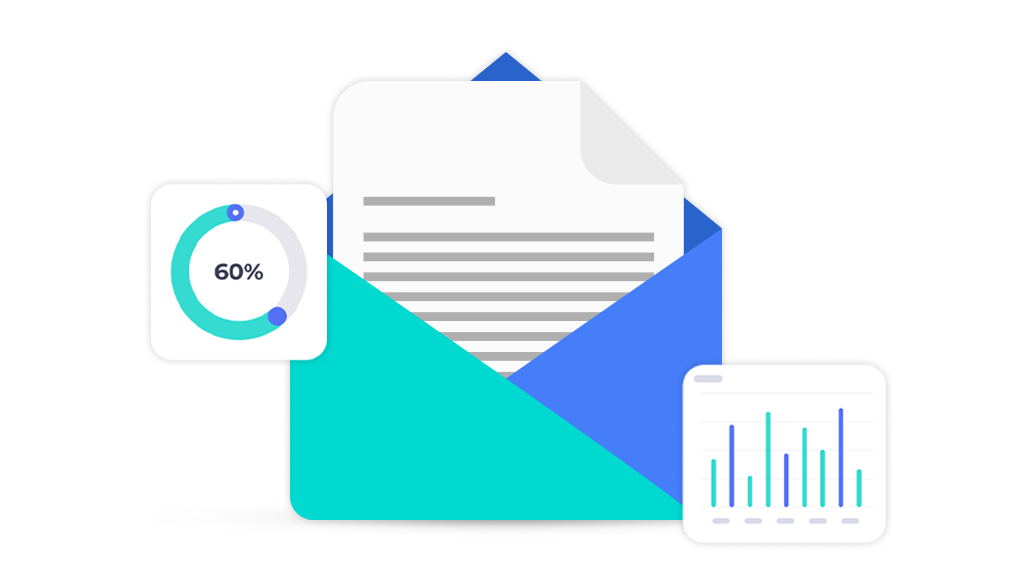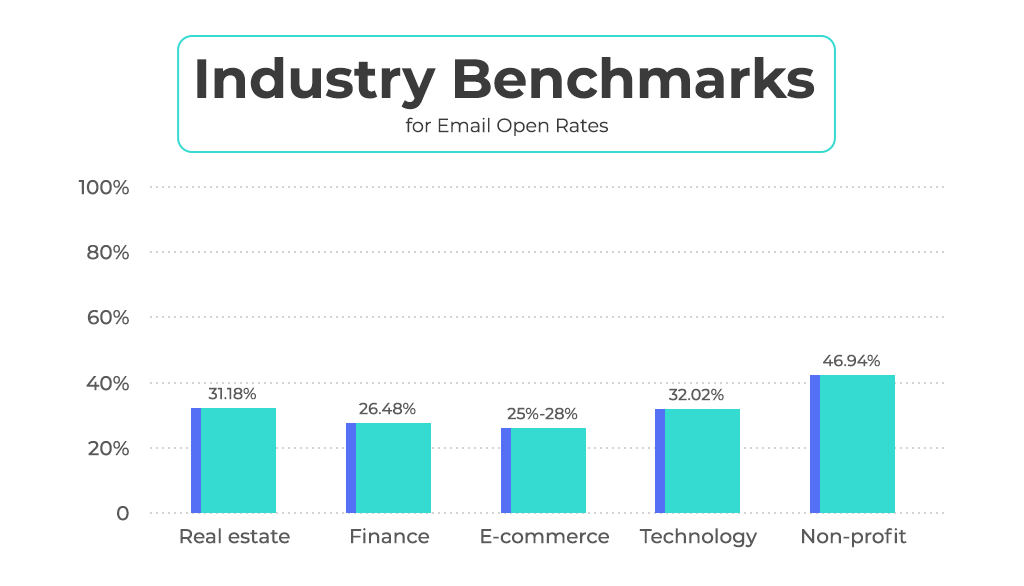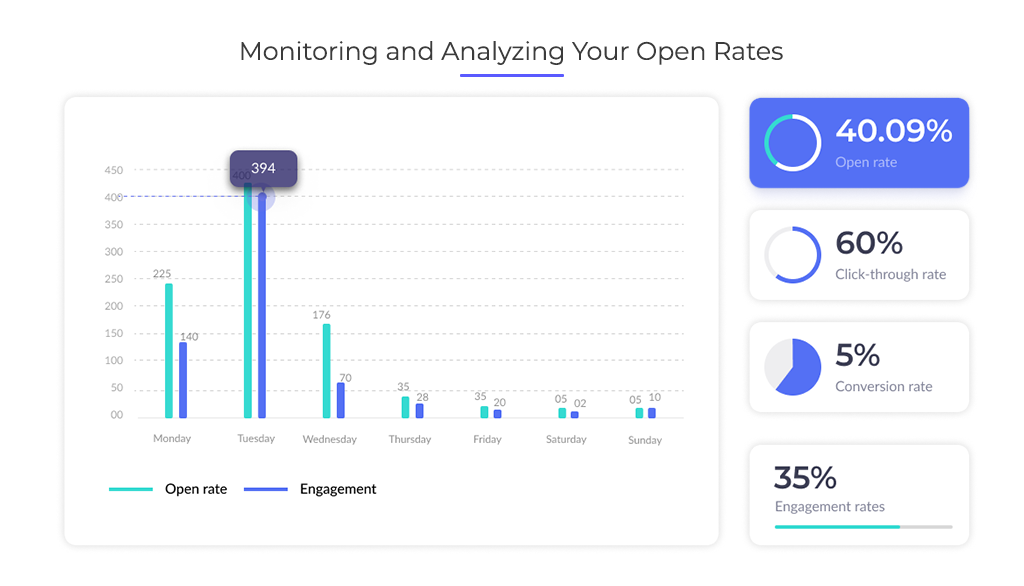HomeBlogsBlogsEmail MarketingWhat Are Good Email Open Rates and How to Achieve Them
What Are Good Email Open Rates and How to Achieve Them
Wondering what are good email open rates? Typically, they fall between 20% and 30%. In this article, you’ll learn about industry benchmarks, […]
Wondering what are good email open rates? Typically, they fall between 20% and 30%. In this article, you’ll learn about industry benchmarks, factors influencing open rates, and strategies to boost your own rates.
Key Takeaways
- Email open rates measure engagement by comparing how many people open your email to how many were delivered, and are crucial for assessing marketing effectiveness.
- A good email open rate varies by industry, with average rates ranging from 25% to 28%, while performance can be improved through effective subject lines, optimal send times, and personalization.
- Common pitfalls such as spam filters, excessive email frequency, and lack of mobile optimization can significantly lower open rates, making it essential to monitor and refine your email strategies regularly.
Understanding Email Open Rates

Email open rates are a cornerstone of email marketing, reflecting how effectively your messages capture your audience’s attention. Understanding what email open rates are and their importance is key to successful email marketing campaigns.
Email open rates are influenced by a myriad of factors such as audience response, experience in email marketing, and industry standards. We will define, calculate, and explain the importance of email open rates, setting a solid foundation for more advanced discussions.
First, we will define email open rates, then explain how to calculate them, and finally, discuss their significance in your email marketing strategy.
Definition of Email Open Rate
At its core, the email open rate is the proportion of recipients who open a particular email compared to the overall number of subscribers to whom the email was delivered. This metric is crucial as it represents the engagement level of your audience. In essence, this ratio indicates how many recipients interacted with your email by opening it.
This is a fundamental metric in email marketing that helps gauge the click through rate of your campaigns and the interest level of your audience.
How to Calculate Email Open Rate
Calculating your email open rate is straightforward but essential. To determine your open rate, divide the number of unique opens by the total number of emails delivered, then multiply by 100 to get a percentage.
For instance, if you sent 1,000 emails and 200 of them were opened, your open rate would be (200/1000) * 100 = 20%. This formula helps you quantify the engagement of your email marketing efforts.
Why Email Open Rates Matter
Monitoring email open rates helps understand the engagement and effectiveness of your email campaigns. These rates allow marketers to assess the success of their subject lines and overall email content. Open rates offer insights into how well your emails resonate with your audience, helping refine strategies for better engagement.
In essence, high open rates indicate successful email campaigns and a well-targeted audience.
What is Considered a Good Email Open Rate?

So, what exactly is a good email open rate? This question often perplexes email marketers, especially beginners. Generally, a good open rate signals that your emails are resonating well with your audience, but this can vary by industry. Understanding what constitutes a good open rate involves looking at industry benchmarks and various influencing factors.
We will explore industry benchmarks, factors influencing open rates, and how to compare your rates to assess performance.
Industry Benchmarks for Email Open Rates
Email open rates can vary significantly across different industries. For example, the average open rate for high-performing sectors typically ranges between 25% and 28%. The government sector has the highest observed email open rate at 46.94%, while the gaming industry has the lowest at 32.02%. Other notable benchmarks include 37.18% for real estate and 26.48% for finance companies.
These benchmarks provide a reference point for evaluating your own internal metrics email marketing performance against industry standards.
Factors Influencing Good Open Rates
Several factors can significantly influence your email open rates. Email deliverability, for instance, directly impacts how many of your emails actually reach recipients’ inboxes. Market trends and the type of content you’re offering also play a crucial role; certain times of the year or trending topics can either boost or hinder engagement.
Knowing your target audience preferences and behaviors helps optimize email engagement and achieve higher open rates.
Comparing Your Open Rates to Industry Averages
Comparing your open rates to industry benchmarks is a crucial step in evaluating your email marketing performance. This comparison helps you understand where you stand and identify areas for improvement. Key metrics to focus on include open rates, click-through rates, and unsubscribe rates.
Regularly benchmarking your performance against industry standards ensures you can refine your strategies and enhance your email marketing campaigns.
Improving Your Email Open Rates
Improving your email open rates is essential for the success of your email marketing campaigns. Higher open rates mean more recipients are engaging with your content, which can lead to better conversions and overall campaign success. There are several strategies you can implement to boost your open rates, ranging from crafting effective subject lines to optimizing send times and personalizing your emails.
We will discuss these strategies in detail and provide actionable tips to enhance your email open rates, starting with crafting effective subject lines.
Crafting Effective Subject Lines
Effective subject lines are crucial for increasing your email open rates. Personalization, such as including the subscriber’s name, has been shown to boost open rates by over 14%. Leveraging data-driven insights allows marketers to refine their subject lines for better engagement.
Applying these strategies can significantly enhance the effectiveness of your email campaign and email campaigns.
Optimizing Send Times
Optimizing the times you send your emails can also have a significant impact on open rates. For example, emails sent on Tuesdays tend to achieve nearly 27% open rates. Early morning hours, specifically between 4 AM and 5 AM, are also effective times for higher engagement.
Analyzing past open rates can help fine-tune your send times for future campaigns. Features like ‘Perfect Timing’ can further boost engagement by sending emails when recipients are most likely to open them.
Personalization and Segmentation
Personalization and segmentation are key strategies for enhancing email open rates. Email content personalized based on the subscriber’s stage in the customer journey can increase engagement.
Segmenting your email list to target smaller groups based on preferences and behaviors makes your emails more relevant to each recipient. This tailored approach makes your emails more appealing and likely to be opened.
Advanced Techniques for Boosting Email Open Rates

For those looking to take their email marketing to the next level, advanced techniques can offer significant improvements in open rates. Techniques such as A/B testing, leveraging preheaders, and using emojis in subject lines can help your emails stand out in crowded inboxes.
We will explore these advanced techniques, beginning with A/B testing different email elements.
A/B Testing Different Elements
A/B testing allows marketers to systematically compare different email variables to see what resonates best with their audience. Testing various aspects like subject line length and content helps identify the most effective options for improving open rates.
For example, using a recipient’s name in the subject line can significantly increase click-through rates.
Leveraging Preheaders
Preheader text optimization provides additional context and can influence a recipient’s decision to open the email. Effective preheader text should complement the subject line and enhance the likelihood of an email being opened.
A well-crafted preheader summarizes email content and entices readers, potentially increasing open rates. Aim for preheaders that are 100-140 characters long to maximize their impact.
Using Emojis and Special Characters
Emojis in subject lines can attract attention and boost open rates. They help emails stand out in crowded inboxes, making them more visually appealing and relatable.
However, it’s crucial to consider the context and audience preferences to ensure the emojis enhance rather than detract from your message. Using emojis thoughtfully can make your emails more engaging and likely to be opened.
Common Pitfalls That Lower Email Open Rates
Even with the best strategies in place, certain pitfalls can significantly lower your email open rates. Understanding these common mistakes can help you avoid them and maintain high engagement levels. Issues such as spam filters, overloading recipients’ inboxes, and ignoring mobile optimization are among the top reasons for low open rates.
We will explore these pitfalls in detail to help you avoid them and ensure your emails get the attention they deserve.
Spam Filters and Deliverability Issues
Spam filters are designed to protect recipients from unwanted spam emails, but they can also block legitimate ones. Factors such as sender reputation, email content, and even generic subject lines can trigger these filters.
To avoid this, authenticate your IP address and sender domain, and ensure compliance with email marketing laws. Understanding spam filters and optimizing your emails can significantly improve deliverability rates.
Overloading Inboxes
Sending too many emails can overwhelm recipients, leading to higher unsubscribe rates and lower engagement. Finding a balance in email frequency is crucial to maintaining recipient interest without overwhelming them, as a crowded inbox can deter engagement and contribute to inactive subscribers.
Implementing a strategic approach to email frequency can enhance open rates and foster better relationships with your subscribers.
Ignoring Mobile Optimization
With a significant number of users checking emails on mobile devices, ignoring mobile optimization can result in poor user experiences and lower engagement rates. Responsive email designs across different screen sizes improve user experience and can lead to higher open rates.
Optimizing for mobile is no longer optional; it’s a necessity for modern email marketing.
Monitoring and Analyzing Your Open Rates

Monitoring and analyzing your email open rates is crucial for continuous improvement. Close monitoring of key metrics allows you to make data-driven decisions to enhance your email marketing strategies. This section will cover setting up tracking metrics, analyzing performance data, and adjusting strategies based on insights.
Let’s dive into the specifics to ensure your email marketing efforts are always moving in the right direction.
Setting Up Tracking Metrics
Implementing a robust tracking system is essential for accurately capturing email open rates and engagement. Use an email service provider that offers a comprehensive dashboard with accessible metrics. Detailed campaign data, including total emails sent and open statistics, helps measure engagement and refine your strategies.
Analyzing Performance Data
Key email marketing metrics to analyze include open rates, click-through rates, conversion rates, and engagement rates. Interpreting these metrics and looking for trends over time helps understand what works and what doesn’t in your email campaigns.
This analysis is key for refining your strategies and improving overall campaign performance.
Adjusting Strategies Based on Insights
Refining your email marketing strategies using performance data can significantly improve open rates. Utilize data insights to identify areas that need adjustment and continuously refine your approach.
Ongoing analysis and adjustments ensure your strategies are always aligned with achieving higher engagement and better results.
Summary
Email open rates are a critical metric for evaluating the success of your email marketing campaigns. They offer valuable insights into recipient engagement and the effectiveness of your strategies. By understanding what email open rates are and how to calculate them, you can set a strong foundation for improving your email marketing efforts.
To achieve good email open rates, it’s essential to compare your performance against industry benchmarks and consider various influencing factors. Crafting effective subject lines, optimizing send times, and personalizing and segmenting your emails are all strategies that can significantly enhance your open rates. Advanced techniques such as A/B testing, leveraging preheaders, and using emojis can further boost engagement.
Avoid common pitfalls like spam filters, overloading inboxes, and ignoring mobile optimization to maintain high open rates. Finally, continuously monitor and analyze your open rates to refine your strategies based on data-driven insights. By doing so, you’ll be well on your way to mastering email marketing and achieving exceptional results.
Frequently Asked Questions
What is a good email open rate?
A good email open rate is typically around 41.31%, but it can vary by industry. Aim to stay close to this average for better engagement!
How can I improve my email open rates?
To boost your email open rates, focus on creating catchy subject lines, sending your emails at optimal times, and personalizing your content for different audience segments. These strategies can make a big difference!
Why do email open rates matter?
Email open rates matter because they show how effective your campaigns are and reflect how engaged your audience is. A higher open rate typically means your subject lines are working and that your content resonates with your recipients.
What factors influence email open rates?
Email open rates are largely influenced by deliverability, market trends, and knowing what your audience prefers. By focusing on these factors, you can significantly boost your email engagement.
How can I avoid common pitfalls that lower email open rates?
To boost your email open rates, focus on passing spam filters, limit the frequency of your emails, and make sure they’re mobile-friendly. These simple steps can make a big difference in how your audience engages with your messages.